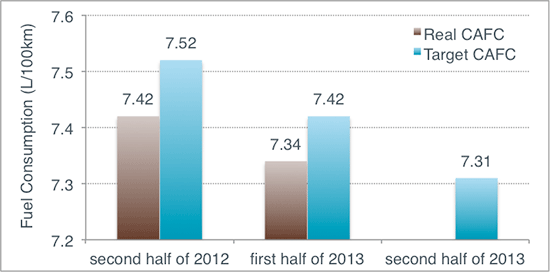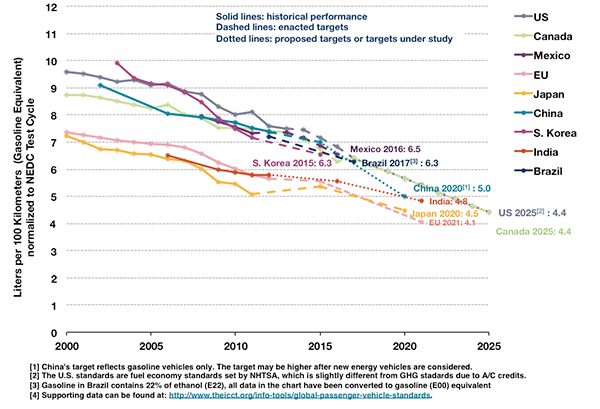Blog
China's fuel efficiency standard for cars: On track to meet 2015 goals—as long as enforcement isn't required
As 2014 begins, China is at the midpoint of a four-year phase-in period defined for the passenger car fuel-consumption target the country adopted in 2011. It’s a convenient moment to take stock. Is China on track to reach its target? The short answer is yes—but a qualified yes.
For background: In 2011, China adopted the Phase III fuel consumption standards for passenger cars, which for the first time set standards for corporate-average fuel consumption (CAFC) instead of individual model fuel consumption. This standard is indexed to 16 curb-weight bins, with an expected fleet-average fuel consumption of 6.9 L/100km for all new passenger cars by 2015. The standard set a phase-in period from 2012 to 2015: manufacturers are allowed to reach 109% of their 2015 corporate-average target in 2012, 106% in 2013, 103% in 2014, and then must fully comply in 2015.
In March 2013, five government departments, led by the Ministry of Industry and Information Technology (MIIT) and the National Development and Reform Commission (NDRC), released an accounting rule specifying procedures for data reporting by manufacturers and detailing accounting methods for calculating corporate average fuel consumption.
But the government has not yet specified any enforcement system for the standard. At this point it is considering publicizing the names of manufacturers that cannot meet their annual targets, as a first step.
In terms of market conformity, while the need to ensure that the fuel-consumption level of post-production vehicles remains consistent with certified level is acknowledged in the document, the accounting rule still does not specify any detailed requirement or procedures for conducting sampling, nor any consequences for nonconforming vehicles.
Progress to date toward the 2015 target
According to MIIT, for the second half of 2012 the average fuel consumption for passenger cars was 7.42 L/100km, or 107.5% of the 2015 target—better than the maximum permissible level specified by the phase-in schedule of 7.52 L/100km. Breaking that down by manufacturer, 35% of domestic (including independent brands and joint ventures) and import vehicle makers have already met their 2015 targets. These manufacturers account for 44% of total new passenger car production and imported volume. Twenty-eight percent of domestic manufacturers and 36% of imports have not achieved their 2012 targets. Overall, the manufacturers who exceeded their performance requirements balanced out those who couldn’t meet the standards, thus the total fleet average met and exceeded the 2012 target.
That pattern continued to hold in the first half of 2013. Statistics released by MIIT for that period showed the fleet-average fuel consumption for new cars as 7.34 L/100km, compared to the target value of 7.42 L/100km. More than half of manufacturers had already met their specific 2013 annual targets at that point, including 62% domestic manufacturers and 56% import vehicle manufacturers.

The trend described by those two reports indicates that China is on track to meet its 2015 fuel consumption target. But the absence of a compliance and enforcement plan, specifically the lack of penalties for noncompliance with the phase-in schedule, is a problem. To fully deliver the promise of energy conservation benefits from the Phase III standard, an effective compliance and enforcement plan that includes prohibitive non-conforming penalties, has to be in place to ensure vehicles produced actually meet the standard limits.
The chart below compares China’s historical fleet-average fuel consumption performance of new passenger cars and future regulatory targets to those in other major markets in the world.
Verification procedure and issues
Under the March 2013 accounting rule, each year manufacturers must submit mid-term and annual reports on corporate average fuel consumption, along with a “pre-annual” CAFC report for the next year, as well as data on production/sales volumes. The China Automotive Technology and Research Center (CATARC) is supporting MIIT on the task of data collection, accounting, and verification. The table below gives a brief review of sources of information used for verifying the CAFC-related data submitted by the manufacturers.
| Domestic vehicles (independent brands and joint ventures) | Import vehicles | |
| Vehicle fuel consumption verification | LDV fuel consumption label information tested by CATARC and published by MIIT | |
| Production/sales volume verification | Vehicle certificate data | Customs forms specifying import vehicle model specification and number of vehicles imported of each model |
CATARC has identified some discrepancies between manufacturers’ reported data and data from public and governmental sources, including unmatched models, specifications, and production/import number, and missing model information, and plans to look into resolving this one-on-one with manufacturers or importers.
The chart illustrates the timeline of CAFC accounting, verification and publication.


